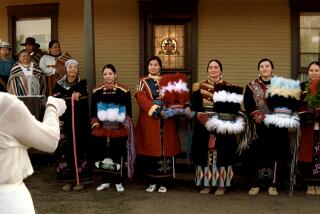Carving Their Way Into Prominence Again
- Share via
NOME, Alaska — Dwight Milligrock is a bit like an Arctic Noah.
But instead of leading birds and animals to the confinement of a 40-cubit ark, this aged Eskimo ivory carver gently shapes them out of a walrus tusk and into the hands of collectors.
And ivory carvings are, these days, increasingly becoming collectors’ items. Objects that a quarter-century ago might have been bought for five bucks are on the market now--depending upon where in Alaska the market is--for 10 times that sum, and sometimes more.
“Carving used to be just one of the things which naturally followed the walrus hunt,” says Milligrock, who’s in his 70s. “But my grandkids, they don’t hunt. They have regular jobs and buy store food. The chain is broken, the tradition is no longer strong.”
For Milligrock, the tradition of ivory carving began when he was 10. Hisfamily lived on Little Diomede Island, about a mile across the Bering Strait from Soviet-owned Big Diomede.
“My father taught me to carve,” Milligrock says. “At first I did not understand how he did it. But as I grew older I would look at a tusk and in my mind I could see the things that were in it. So I would use my tools to get those things out--seals and puffins and whales and polar bears.”
Ivory carving dates from Eskimo prehistory. Harpoon heads and household implements and combs were whittled from it. Soon man’s creative urge became evident, and the “spirit world” of these Arctic peoples was manifest in what emerged from the ivory.
But these days the rifle is the weapon of preference, stores supply most other needs, and the shadowy old mystical world is replaced by more conventional suburban religions.
What’s made now is made to market. But that is not to say it isn’t done just as artfully, or with just as much pride, as in the past.
The tools have changed. The adz and the file have been largely succeeded by high-speed, precision electric power tools. Milligrock, who lives in Nome, says that he can carve in just one day what years ago would have taken two or three times as long.
“There is nothing wrong with making life easier,” he says. “After all, just because my wife uses a gas stove does not mean that the food is less good than when she cooked over a driftwood fire.”
As is the case with the better artists, Milligrock’s work is distinctive. He says someone who knows ivory can look at six carvings and give the names of each of the half a dozen men who did them.
“It may be the manner in which the foot of a polar bear is carved,” Milligrock says, “or the way India ink is used to make the eyes.”
It has only been within the last three decades or so that the general public has come to appreciate the simple, clean-lined beauty and luster of traditional Eskimo ivory carving.
One of the reasons for this is the cultural chauvinism that for so long considered any work of a “primitive” people to be of little value. Another is that some people perceived, ludicrously enough, that walrus ivory looked “just like plastic.” And, of course, ivory used to be so inexpensive as to suggest it really couldn’t be worth anything in the first place. A carving was nothing more than a curio or a trinket.
“People want ivory carvings now because they are starting to acknowledge its value artistically,” Milligrock says. “It’s a credit that’s long overdue.”
It may have taken some time for the ivory carver to have his day in the sun. But thousands of Alaska visitors and residents regard these carvings as highly valued works of art.
It is illegal for a non-native to possess walrus ivory that has not been crafted, such as an uncarved walrus tusk or one that has not been scrimshawed.
When buying ivory, seek assurance that the object is made of Alaska walrus ivory. Some items are made from congealed fish bone, elephant ivory or from the tusk of the narwhal and shipped to Alaska for sale. Most merchants are honest enough to give a straight answer. Hint: Walrus ivory is generally creamy and has a rich, inner glow. The other materials are whiter and usually lighter in weight.
Don’t worry if the core of the tusk is visible on the surface of a carving. The core is granular and is the internal, third layer of material from which a tusk is made. Still, a carving without exposed core is more uniform and pleasing in appearance.
As ivory ages, some cracking may appear on the surface. Many people swear that continuing applications of Johnson’s Baby Oil, 3-in-1 Oil or linseed oil will prevent such manifestations of aging. An equal number say nothing can prevent it.
When looking for traditional works, seek objects that have few carved details. For example, incised indications of fur on a polar bear or folds on the hide of a walrus should not be evident. Such detailing is indicative of a more modern approach, and many carvers executing the contemporary look are as skilled as the traditionalists.
Carvings of birds and some types of seals are often highly detailed. But this is done with ink, not carved, and is characteristic of the traditional school.
As with anything else that sits around on display, ivory accumulates the normal household residue. According to Nome’s Jim West, probably Alaska’s biggest ivory dealer, the best bet for cleaning ivory is Pledge furniture polish.
For more than a hundred pages of details on traveling in Alaska, get “The Vacation Planner” by writing to Alaska Division of Tourism, P.O. Box E-007, Juneau, Alaska 99811.
More to Read
Sign up for Essential California
The most important California stories and recommendations in your inbox every morning.
You may occasionally receive promotional content from the Los Angeles Times.













